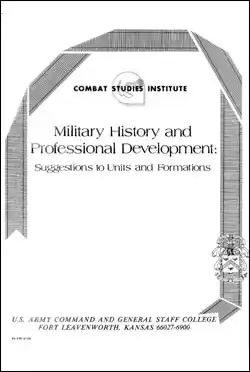
By Lieutenant Colonel Gary L. Bounds, Lieutenant Colonel John A. Hixson, Lieutenant Colonel Gary H. Wade, Major Gary B. Griffin, Major Scott R. McMichael, Major Andrew N. Morris, Major Claude R. Sasso, Captain Thomas P. Odom
39 Pages
Published: 1985
This pamphlet is designed to provide ideas for the use of military history and military history related activities in fostering professional development. The ideas presented here, with some exceptions, do not require great expertise in the historical arena for their implementation. They are simply designed for use by service members, unit commanders, and school commandants to enhance soldier awareness of the past and thereby to instill in us pride and esprit de corps in our profession. This pamphlet is not limited to ceremonial programs and exhibits but encompasses a wide range of activities, such as battle analyses and staff rides. The broad scope of the pamphlet will aid the user in picking those ideas that best fit the needs of the individual, unit, or organization.
Download the PDF